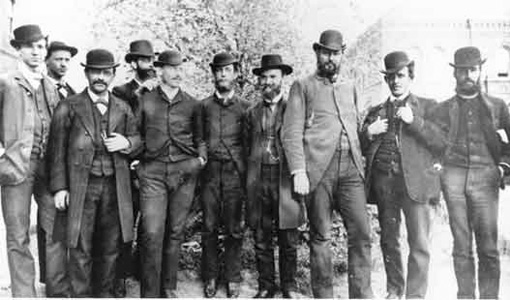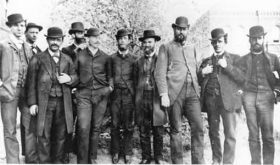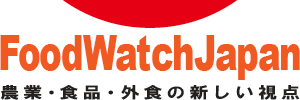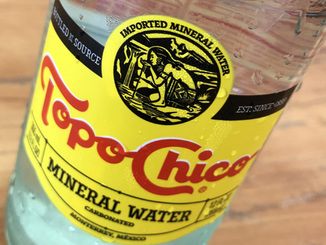

薄めたミルクのたんぱく質の栄養価を見掛け上高めるために工業用化学物質のメラミンが使われた最近の中国における公衆衛生上の危機は、1900年代初頭に米国食品医薬品局(FDA)が設立されることとなった事件を彷彿させる。Wiley博士のあの有名な「毒物捜査班」を想起させるのだ。
Melamine Tainted Milk in China: A Case of Food Adulteration, a Long Standing Economic and Safety Concern for the Food Industry and the Public
The recent public health crisis in China involving the use of the industrial chemical, melamine, to enhance the apparent protein quality of diluted milk illustrates the concerns that led to the formation of the U.S. Food and Drug Administration (FDA) in the early 1900s. It also brings to mind Dr. Wiley’s famous “poison squad.”
今日、加工食品は複雑な世界市場を移動する。メラミン混入の中国産食品が日本でも、また遠くパナマでも見つかっている。各国の保健衛生当局は、視察や検査に当たって、また国民を守るため、さらには、健康被害をもたらした中国のメラミン汚染ミルクの事例にあるように、悪徳食品業者の消費者に対する不正行為防止のため、有効な法的手段を備えていなければならない。
何十年、いや、何世紀にもわたって、悪徳食品業者は、疑いを持たない一般市民に対して粗悪な食品を売りつけたり、食品に粗悪な原料を加えて売ったりして利益を上げようとしているのだ。15世紀のヨーロッパでは、食に付する動物の屠畜は市中で行われるよう法律で定められていた。動物が徒歩で市場に連れてこられることによって、検査もでき、健康かどうか判断できるからだ。1800年代から1900年代初頭の米国では、化学物質を食品に添加することや、食用に動物を屠畜することを規定する国内法はなかった。
食の安全性への懸念が高まり、米国農務省(USDA)は農産物に使われる化学物質の調査を始めたが、人的資源も乏しく、国民の健康を守るに当たっての権限もごく限られたものだった。「FDAの父」と呼ばれるHarvey Wiley博士がUSDAの化学課(FDAの前身)の主任化学官になったとき、博士は食品や薬品に加えられる化学物質の調査を拡大した。その取り組みの1つには、有志が実際にさまざまな化学物質を摂取し、どういう健康影響が出るかを調べるものまであった。
かの有名な「毒物捜査班」(写真参照)とWiley博士の研究は広く公に知らされ、混ぜ物が加えられた粗悪な食品や医薬品が作られないよう、国の法令制定の動きを紡ぎ出した。米国に新たに食品医薬品法が制定されるに至った決定的な出来事は、1906年にUpton Sinclairの書いた「The Jungle」が出版されたことだ。その本は、食肉加工業の不衛生でひどい実態を暴いた。
米国議会は同年、食用獣肉検査法そしてWiley法として知られる食品医薬品法を可決した。それらの法律によって、安全でない粗悪な食品や医薬品が各州間に出荷されることが違法となり、さらに、違法な製品を差し押さえ、そのような製品を販売する個人に対して刑事訴訟を起こす権限が政府に与えられた。過去100年間、USDA(食用獣肉・家禽肉、および一部の鶏卵製品を管轄)とFDA(その他すべての食品と食品原料を管轄)は、米国の消費者を健康被害からまた経済的詐欺行為から守るため、粗悪品規定を実施してきた。
食品の不純物混入は、少なくとも最近の米国では、その食品が安全でないということよりもむしろ、その製品のその価値は本当はもっと低いものだということを隠し、消費者を欺く経済的詐欺行為であることが多い。ほとんどの場合、生産費を削減できる害のない物質が使われている。しかし、製品表示には明記されないのだ。
例えば、FDAのウェブサイトによると、1900年代初頭にあったケースでは、生産者の費用を削減し利益を上げるため、牛乳に水が混ぜられていた。近年、FDAは、食品に関して経済的詐欺行為を働いた個人に対する法的訴訟に勝っている。その例は、オレンジジュース、リンゴジュース、メープルシロップ、はちみつ、クリーム、オリーブオイル、海産物に及ぶ。例えばこんな具合だ。より高価なサーモンに似せるためマスに色素を加えるなど。
私がFDAに勤めていた初期、粗悪品を巡るこんなケースがあった。業界は、異性化糖を甘味料として清涼飲料に使い始めたころだった。異性化糖は、化学的にははちみつとほぼ見分けがつかない(安全とみなされる理由の1つ)。数社の企業が、より安価な原料である異性化糖をその使用を表示に明記することなくはちみつに添加していた。異性化糖混じりのはちみつを検出するため、FDAは高度な分析方法を開発しなければならなかった。
粗悪なオレンジジュースのケースでは、悪徳業者が莫大な儲けを上げていた。安価な原料を用いながら1つ上の品質の製品であると表示するのだ。例えば、テンサイ糖を混ぜていながら「100%オレンジジュース」というふうに。FDAのウェブサイトによると、あるメーカーはおよそ20年間に渡って、4500万米ドルも消費者から巻き上げていたという。別のメーカーは、テンサイ糖をオレンジジュースに混ぜ、FDAが訴訟を起こし有罪判決が宣告されるまでに5700万米ドルの利益を上げていた。
FDAに訴訟を起こされると、多額の罰金刑と懲役刑さえ言い渡されることがある。ある兄弟2人は、はちみつやピュアメープルシロップなど混ぜものをした粗悪品を販売した件で、それぞれに罰金2万米ドルと19カ月、30カ月の懲役が言い渡された。ある企業は、量り売りのホタテ貝に水を加えていた件で12万米ドルの罰金が科された。こういった法的手段は、悪徳業者による詐欺行為抑止になるとFDAは信じている。
中国から日本に輸入されたメラミン混入チョコレート、パン菓子、肉まんそして卵製品による健康被害、あるいは死亡の報告はない。しかしながら、中国におけるメラミン混入事件は、4人の赤ちゃんが死亡、5万人以上が病気になるなど深刻である。米国では昨年、中国から輸入したメラミン汚染のペットフードによって多くのネコやイヌが死亡した。最近のメディア報告によると、中国の指導者は、汚染ミルク事件についてその一部責任を認めたという、そして「この事件から深い教訓を得るだろう」と伝えている。中国が同国の食の安全性システムを向上させるにあたり日本や米国を参考にしてくれることを望む。
参考文献:英文記事末尾を参照ください
Today food products move in a complex global market. Food products adulterated with melamine from China have been found in Japan and as far away as Panama. National health authorities must have sound legal tools for inspection, testing, and enforcement to protect the public and to discourage unscrupulous purveyors of food products from cheating consumers and, as is the case for melamine adulterated milk products in China, from causing adverse health effects.
For decades, even centuries, unscrupulous purveyors of food have tried to increase profits by offering inferior food products and by adding inferior ingredients to food products sold to the unsuspecting public. In 15th Century Europe, laws required that the slaughtering of animals for meat be conducted within the city so that the animals brought to market “on foot” could be inspected and determined to be healthy. In the U.S. in the 1800s and early 1900s, there were no national laws that governed the addition of chemicals to food or the slaughtering of animals for meat.
As concern about food safety increased, the U.S. Department of Agriculture (USDA) began research on chemicals used in agricultural products but had few resources and little authority to protect public health. When Dr. Harvey Wiley (the father of FDA) became chief chemist of the USDA’s Division of Chemistry (the forerunner of FDA), he expanded research on chemicals added to food and drugs. Part of his effort involved having volunteers consume various chemicals to see how their health might be affected.
The now famous “poison squad” (see photo) and Dr. Wiley’s research was widely publicized and generated support for national legislation to prevent adulteration of food and drugs. The crucial event that led to a new food and drug laws in the U.S. was the publication of Upton Sinclair’s book The Jungle that exposed the terrible, unsanitary conditions of the meat packing industry.
The U.S. Congress passed the meat inspection act and the food and drug act (known as the Wiley Act) of 1906. The laws made the interstate shipment of unsafe, adulterated foods or drugs illegal and established the authority for the government to seize unlawful products and to initiate criminal action against individuals who marketed such products. For the past one hundred years, USDA (meat, poultry, and some egg products) and FDA (all other food and food ingredients) have enforced the adulteration provisions to protect American consumers from adverse health effects and from economic fraud.
The adulteration of food, at least in recent U.S. experience, does not usually result in unsafe food; rather it is economic adulteration and hides the true, lower value of a product, thus deceiving consumers. In most cases harmless substances that reduce the cost of production are used but their use is not declared on the product label.
For example, according to the FDA web site, water was added to milk in the early 1900s to reduce manufacturers’ costs and thus boost profits. In recent years, FDA has won legal action against individuals who caused economic adulteration of foods such as orange juice, apple juice, maple syrup, honey, cream, olive oil, and seafood. For example, color has been added to trout to resemble salmon, a more expensive fish.
I recall one example of economic adulteration during early my years at FDA. Industry had begun to use high fructose corn syrup (HFCS) as a sweetener in soft drinks. HFCS is chemically nearly indistinguishable from honey (one reason it was considered safe). Some firms added HFCS, a cheaper ingredient, to honey without disclosing the use of the added ingredient on the label. To detect cases of honey adulterated with HFCS, FDA had to develop sophisticated analytical methodology.
Cases of adulteration of orange juice show the huge profits that can be made by unscrupulous vendors who substitute cheaper ingredients and then label the product as a superior one (for example, “100% pure orange juice” adulterated with beet sugar). According to the FDA web site, one manufacturer defrauded consumers of over $45 million over a period of twenty years. Another manufacturer used beet sugar to adulterate orange juice to achieve $57 million in profit before FDA’s legal action led to conviction and sentencing.
FDA’s legal action can result in substantial fines and even prison time. Two brothers were convicted and fined $20,000 each and sentenced to 19 and 30 months in prison for adulterating foods such as honey and pure maple syrup. One firm was fined $120,000 for adding water to scallops which are sold by weight. FDA believes that such legal actions will discourage other unscrupulous vendors.
The chocolate, pastries, steamed meat buns, and egg products from China tainted with melamine have not caused any reported illness or deaths in Japan. However, the seriousness of the melamine incident in China is reflected in the reported deaths of four babies and illness of some 50,000 individuals. Last year pet food from China contaminated with melamine caused the deaths of many cats and dogs in the U.S. Recent media reports indicate that the Chinese leadership has acknowledged partial responsibility for the contaminated milk incident and will “draw deep lessons from it.” One can hope that China will look to Japan and the U.S. as it works to improve its food safety system.
REFERENCES Sacred Cow, Mad Cow, by Madeleine Ferrieres, Columbia University Press, 2006
History of the FDA
The 1906 Food and Drugs Act and Its Enforcement
Fake Food Fight
Picture:Harvey Wiley, third from right, is photographed with his staff from the Division of Chemistry, U.S. Department of Agriculture, not long after he arrived in Washington in 1883
※このコラムは「FoodScience」(日経BP社)で発表され、同サイト閉鎖後に筆者の了解を得て「FoodWatchJapan」で無償公開しているものです。




